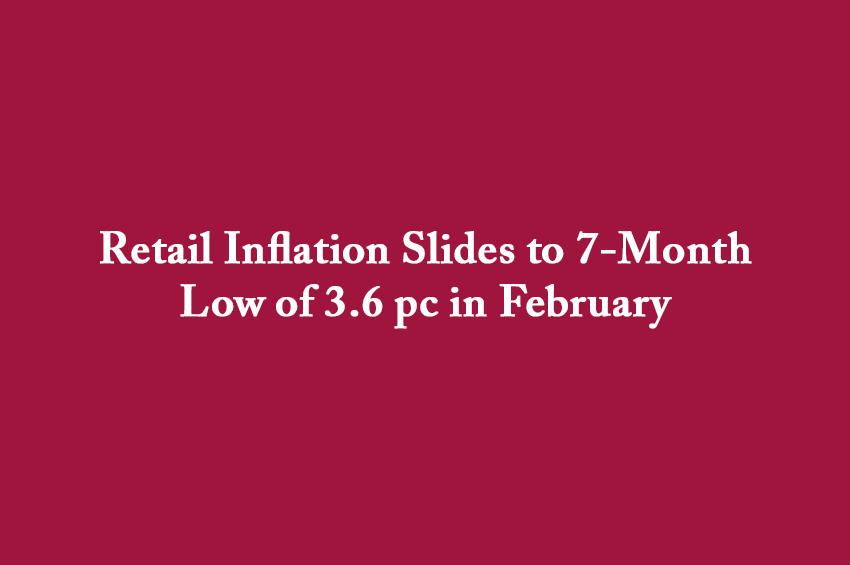Winning Bizness Economic Desk
Retail inflation in the country slid to a seven-month low of 3.61 per cent in February, as food inflation moderated below four per cent for the first time in nearly two-years.
An important highlight here is that this southward movement in February marks only the third time this fiscal (FY 25) that inflation has fallen below the four per cent mark.
Because of this decline, there are expectations of a back-to-back rate cut in April by the Reserve Bank of India (RBI).
Notably, food inflation eased to 3.75 per cent—its lowest reading in 21-months—as vegetables moved to deflation with prices declining 1.1 per cent from the previous year, compared with the 11.4 per cent increase in January.
Food prices had registered a six per cent growth over the previous year while pulses, which have been on a downward trajectory, also registered a deflation in February compared with a 2.6 per cent increase in prices. Fruit and oil inflation on the other hand, moved up in the month.
What needs to be noted here is that core inflation rose at its fastest pace in seven-months as gold pries climbed up steeply in the month.
Miscellaneous goods inflation increased to 4.8 per cent in February from 4.4 per cent in the previous months as personal care and effects inflation rose to 13.6 per cent from 10.6 per cent.
The country’s apex bank expects inflation to remain muted in the coming year with the FY 26 inflation estimated at 4.2 per cent. The MPC had delivered its first rate cut in February, as it reduced the policy rate to 6.25 per cent from 6.5 per cent.
High Gold, Personal Care Products Prices Push Up Inflation in Kerala
Inflation in the southern state of Kerala was high, pushed up by spiralling gold, personal care items and coconuts. However, in several other states of the country, there was a reduction in prices in line with the overall figure easing to a multi-month low in February.
In that month, Kerala’s inflation rose to a five-year high of 7.3 per cent from 6.8 per cent in the previous month, even as food inflation dipped to a 21-month low, driving down the country’s retail inflation to a seven-month low of 3.6 per cent.
The southern state’s inflation has been over six per cent since October 2024.
Kerala’s inflation was more than twice that of the country as the state spent 2.5 times more on personal care and effects, which includes gold, compared to the national average.
The rise in gold prices could be a reason for this as gold inflation increased to a 53-month high of 35.6 per cent last month, as global uncertainties along with a depreciation in the Rupee pushed up costs.
Gold, which accounted for a 25 per cent share in personal care and effects inflation, increased to 13.6 per cent as compared to the 10.6 per cent of the previous month.
Gold could be one factor driving up inflation in Kerala, as the state spends more than twice as much on personal care and effects than the national average.
While personal care and effects had a 4.25 per cent share in the inflation basket covering rural areas and a 3.57 per cent share in urban areas across the country, in Kerala, this category occupies a higher weight at 10.4 per cent in rural and 6.6 per cent in urban areas of the state.
An important point to note here is that it is not just gold alone—data shows that Kerala had a higher share of spending on prepared meals, fruits, meat and fish and items like health, transport and communication and recreation services.
Personal care and effects also include spending on toiletries and services like barbers and beauticians. Power, cream, lotion and perfume inflation was at a 16-month high of 3.8 per cent in February.
Fruits’ share in the inflation basket was nearly 40 per cent higher than the national average.
Inflation in this category touched a ten-year high of 14.82 per cent in February as prices rose for a fourth consecutive month
Coconut oil and coconuts, a staple in the state, witnessed an inflation rate of 55 per cent and 41.6 per cent, respectively.
India’s Forex Reserves Surge by USD 15.26-billion
The country’s foreign exchange reserves clocked a big jump of USD 15.267-billion to USD 653.966-billion during the week ended March 7. The highlight here is that this is the largest increase in over two-years.
This northward climb follows a decline of USD 1.781-billion in the previous week, which brought reserves down to USD 638.698-billion.
The recent increase in reserves is largely attributed to a USD 10-billion forex swap executed by the Reserve Bank of India (RBI) on February 28.
In the swap, the RBI purchased dollars in exchange for Rupees, a move aimed at easing liquidity and stabilising market conditions.
The overall increase in reserves was mainly driven by a significant jump in Foreign Currency Assets (FCAs), which climbed up by USD 13.993-billion to USD 557.282-billion.
These assets include the impact of fluctuations in non-US currencies such as the Euro, Pound and Yen.
Gold reserves also witnessed an uptick, rising by USD 1.053-billion to USD 74.325-billion during the week.
The Special Drawing Rights (SDRs) increased by USD 212-million reaching USD 18.21-billion.
However, India’s reserve position with the International Monetary Fund (IMF) declined slightly by USD 69-million, standing at USD 4.148-billion according to RBI data.
This sharp climb comes after the country’s forex reserves had been on a declining trend due to market interventions and revaluations.
At its peak, the country’s forex reserves had reached an all-time high of USD 704.885-billion in September 2024.
India’s Industrial Output Growth Rises to 5 Per Cent in January
India’s industrial production growth accelerated to five per cent in January 2025, driven by a rebound in manufacturing activity, according to official data.
Here, it must be pointed out that the government has also revised the December 2024 industrial output figure to 3.5 per cent from the provisional estimate of 3.2 per cent released in the previous month, an official statement said.
The Index of Industrial Production (IIP) growth in November 2024 was five per cent.
The pace of factory output growth stood at five per cent in January 2025. The country’s factory output measured in terms of Index of Industrial Production witnessed a 4.2 per cent growth in January 2024.
Data released by the National Statistical Office (NSO) showed that the manufacturing sector’s output grew by 5.5 per cent in January 2025, up from 3.6 per cent in the year-ago month.
Mining production growth declined to 4.4 per cent from six per cent Year-on-Year (YoY). However, power output growth slowed to 2.4 per cent in January 2025 from 5.6 per cent a year ago.
In the April-to-January 2024-25 period, the IIP grew 4.2 per cent, slower than the six per cent registered in the year-ago period.
As per use-based classification, the capital goods segment growth accelerated to 7.8 per cent in January 2024 against 3.2 per cent in the year-ago period.
Consumer durables (white goods production) grew by 7.2 per cent during the reporting month as against a growth of 11.6 per cent in January 2024.
In January 2025, the consumer non-durables output contracted 0.2 per cent as compared to a growth of 0.3 per cent a year ago.
Data showed that infrastructure/construction goods reported a growth of seven per cent in January 2025, up from the 5.5 per cent expansion in the year-ago period.
Data also showed that the output of primary goods logged a 5.5 per cent growth in January 2025 as against 2.9 per cent a year earlier.
Expansion in the intermediate goods segment was 5.2 per cent in the month under review, slightly down from 5.3 per cent a year ago.


